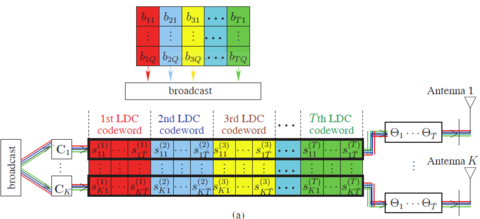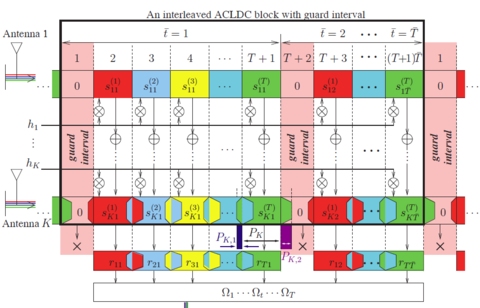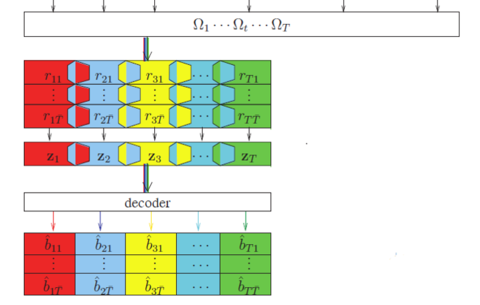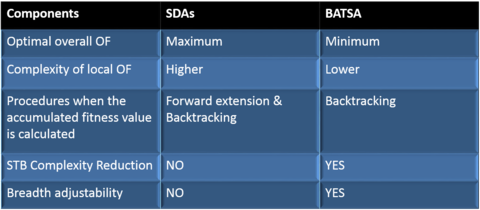Summary
The linear dispersion structure is employed to accommodate the dynamic topology of cooperative networks, as well as to achieve higher throughput than conventional space-time codes based on orthogonal designs. Asynchronous Cooperative Liner Dispersion Codes (ACLDC) are applied to achieve full diversity in the presence of asynchronous reception. To achieve a near ML performance with much lower decoding complexity, we present an Ant-Colony Optimization (ACO) based decoder. In addition, a block-code based general model is proposed to combat the Inter-Symbol Interference (ISI) caused by frequency selective channels in a Multi-Input Multi- Output (MIMO) system and/or by asynchronous cooperative transmissions. The general model is not only exemplified by the Time-Reversed Space-Time Block Code (TR-STBC) scheme, but also by the Asynchronous Cooperative Liner Dispersion Codes (ACLDC) scheme. In these schemes a guard interval has to be inserted between adjacent transmission blocks to mitigate the effect of ISI. Consequently, this could degrade the effective symbol rate for a small block size. A larger block size would enhance the effective symbol rate and also substantially increase the decoding complexity. In the general model proposed in this paper, we further present a novel low-complexity breadth adjustable tree-search algorithm and compare it with Sphere- Decoding (SD) based algorithms.
Description
Transmit diversity is a very significant characteristic which a Multiple-Input Multiple-Output (MIMO) communication system possesses. Nevertheless, due to the size of a mobile phone, the
10λ distance between two antennas allowing each channel to be independent is difficult to fulfill. Against this background, the idea of ‘cooperative diversity’ is proposed in to exploit independent nodes instead of multiple antennas as the sources to transmit signals, while achieving the same transmit diversity gain. However, synchronization of signals transmitted from different nodes is difficult to achieve, due to the inequivalent propagation delay introduced by different channels. Hence, the disadvantage of asynchronous transmission - Inter-Symbol Interference (ISI) – needs to be taken into account when a certain MIMO technique is applied to provide transmission diversity gain.
Inter-symbol Interference (ISI) can be caused by many factors. In this paper we mainly deal with the ISI incurred by frequency selective fading in Multi-Input Multi-Output (MIMO) systems and/or by asynchronous transmissions in cooperative networks. To handle either case, a number of block-based transmitting and receiving schemes, which contain T codewords per block, have been invented based on the structure of a single codeword of the space-time diversity scheme provided for channels without ISI. These block-based transceiver schemes aim at minimizing the effect of ISI while maintaining the same order of diversity, as achieved by their single-codeword counterparts in systems without ISI.
Amongst them are Time-Reversed STBC (TR-STBC) which is designed for MIMO systems with frequency selective channels, the shift group-decodable STBC when synchronization cannot be achieved in a wireless relay network, as well as Linear Asynchronous STBCs (LA-STBCs), and Asynchronous Cooperative Linear Dispersion Codes (ACLDCs) where both are devised to mitigate the ISI aroused by asynchronous cooperative transmissions. ACLDCs are more robust than LA-STBCs when the asynchronous delay τ is not an integral multiple of the symbol durations Ts. Nevertheless, all the above mentioned techniques are only capable of removing the ISI between symbols within identical codewords. The ISI between symbols belonging to adjacent codewords has to be removed with the aid of nonlinear detector/decoders. The optimal detector is the Maximum Likelihood (ML) detector. As a guard interval with a fixed length has to be inserted between any two contiguous blocks, a larger block size will result in a higher effective transmission rate. However when a larger block size is adopted, the complexity imposed by the ML detector becomes extensive. It has been mentioned that lattice-decoding algorithms can be used to decode their respective schemes. However, no details of the algorithms were provided.
We would propose a novel low-complexity Ant Colony-Optimization (ACO) based algorithm to solve the optimization problem presented by the ACLDC decoder. This population based approach has recently been applied to a large number of so called Non-deterministic Polynomial (NP)-hard combinatorial optimization problems.
In order to combine the above-mentioned various state of-the-art transceiver schemes developed to combat ISI, we propose a general model covering from the un-coded information symbols to the objective function of the detection algorithms. Then our main contribution is to design a novel low complexity tree-search detection algorithm based on the proposed general model.




Major Accomplishments
We demonstrate by simulation that the novel ACO-based ACLDC decoder is able to provide the system with near ML performance at a significantly reduced complexity. The proposed novel tree-search based algorithm that employs an Objective Function (OF) providing the optimal solution with the maximum overall fitness value, which imposes a significantly lower complexity than the OF of the Sphere Decoder (SD)-based algorithms. Besides, our algorithm will not search from any sister branch at any level if the current partial path is only made up of states ranked first in each column. This can significantly reduce the overall computation complexity without a loss of performance. Last but not least, in our approach the searching range M is user-defined and can be adjusted with the least computation complexity. All these features make our algorithm achieve the same Bit-Error Rate (BER) as obtained by the exhaustive searching algorithm, with a complexity not only lower than Viterbi Algorithm (VA) or ML, but also lower than the SD algorithms.

